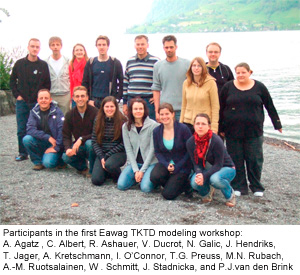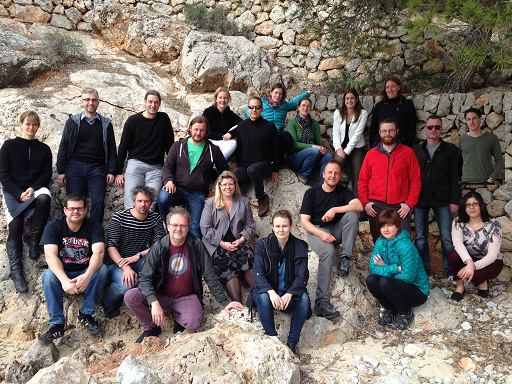
DEBtox information
Making sense of ecotoxicity test results

Main menu
Submenu
| |
||
 DEBtox information Making sense of ecotoxicity test results |

|
|
|---|---|---|
Main menu |
Submenu |
|
DEBtox information |
DEBtox information |
|
What does GUTS stand for?Originally GUTS was meant as "Grand Unified Theory for Survival" (as a tongue-in-cheek reference to the GUTs in particle physics). Later, we changed it to the more suitable "General Unified Threshold model for Survival", but kept the acronym (which is the most important thing anyway). |
|
What is GUTS all aboutToxicokinetic-toxicodynamic modelling (see about DEBtox for explanation) for survival has been quite popular over the last two decades. Many, apparently very different, models have been developed, which has led to confusion among model developers and model users. In 2010, Roman Ashauer and Thomas Preuss organised a workshop in Eawag's facilities in Kastanienbaum, Switzerland, to discuss TKTD models, with a specific aim to address this confusion in survival models. The participants are shown in the picture, but it's up to you to find out who's who. During the discussions (and at night, somewhere between sleeping and being awake), I found the final piece of the puzzle that enables us to view all currently-applied survival models as special cases of one over-arching framework. These special cases result by setting parameters of an over-arching model (which became GUTS) to specific values. In this way, GUTS shows how these apparently very different models are related, and aids the exploration of the most useful representation of survival for particular species-chemical-data combinations. |
 |
Where is GUTS published?A group of four people from the workshop worked out the details of GUTS and published it: the two organisers (Roman and Thomas), together with Carlo Albert and myself. GUTS was published in Environmental Science & Technology in 2011, and can be found as DOI 10.1021/es103092a. I collect the papers that apply hazard models (specific cases of the GUTS framework) in a list over here. Also, check out Roman's page on GUTS. In 2018, Roman and myself have released an extensive e-book on GUTS, which is the definitive guide to the framework. There is no better way to start learning about GUTS than this book. The first version was released on 18 January 2018, but several updates have appeared since. More information. |
|
Why don't all individuals die at the same time?There are two very different views on this, which have been combined in GUTS. The most popular view in current-day ecotoxicology is 'individual tolerance' (IT). IT assumes that an organism dies when some dose metric (e.g., the internal concentration or body residue) exceeds a threshold. Not all organisms die at the same time because each organism has a different value for the threshold. It is often assumed that the threshold follows a log-normal distribution in the test population, which underlies the popular probit analysis. The alternative view is 'stochastic death' (SD). SD assumes that all animals do not die at the same time because death is best viewed as a chance process. Each individual in a test container has the same probability to die, but chance decides which ones will go. This leads to a different statistical approach named survival analysis. Survival analysis is popular in many fields (e.g., insurance and engineering), but not too well known in ecotoxicology. A nice discussion on this subject was written by Newman and McCloskey (2009). |
 |
What is the relationship between GUTS and DEBtox?GUTS and DEBtox are both TKTD approaches, and show some overlap. GUTS deals with survival only (and possibly other quantal endpoints), whereas DEBtox deals with a whole range of organism responses (not only survival, but also growth, reproduction, and in principle also respiration, body composition, product formation, etc. etc.). The survival component of DEBtox models is always some special case of GUTS; most commonly the reduced hazard model. It is good to realise that DEB theory includes the survival aspects of life history as well, and focusses on stochastic death (SD) as the dominant process. GUTS deals only with survival, and additionally considers individual tolerance (IT) and combinations of IT and SD. GUTS models are derived and used without reference to DEB theory (as there are no energetic aspects considered). Therefore, it is confusing to refer to GUTS models as DEB or DEBtox models, although this is done in some publications. |
 |
What is the regulatory status of GUTS?GUTS has been used already for some time in dossiers for plant protection products (pesticides) in Europe. The regulatory application has been facilitated considerably by the 2018 EFSA opinion on TKTD models, which explicitly discusses GUTS (and DEBtox). GUTS was considered "ready for use in aquatic ERA" in this EFSA opinion. The model application was specifically focussed on Tier 2C (using refined exposure scenarios from fate models) although the model could easily be used in Tier 1 (e.g., simple LC50 derivation) as well. Earlier, one of the predecessors of GUTS, the DEBtox-survival model, was included in OECD guidance, next to more classical methods that derive NOECs and ECx. More recently, in 2023, GUTS use has been prescribed in the updated EFSA guidance document for bees to extrapolate to exposure durations beyond the tested ones. GUTS is also mentioned as a possible tool in the 2023 EFSA guidance for birds and mammals. Is there software for GUTS?Yes, I can highly recommend the openGUTS software (as I was involved in its development), which is freely downloadable as Windows executable or Matlab package. This software was developed over the course of 2018/2019 in a Cefic-LRI funded project. It only applies the reduced GUTS model for pure SD and pure IT. Dedicated website for the openGUTS software. More information on the project. On this website, I provide Matlab packages for the BYOM platform (more flexible than openGUTS, but less user-friendly), and provide links to other software (such as several R packages). You can start in the software section on this website. If you have a version of the 'DEBtox for Windows', you can still use that for the DEBtox-style survival analysis (scaled toxicokinetics, constant exposure, hazard model), but the use of this software for sub-lethal effects is not recommended (there are some errors in the program, and it is not maintained anymore). There is some work going on with people developing GUTS implementations, and user interfaces for them, so more is about to emerge in the near future. I will try to keep track of what comes out in the miscellaneous software section. Is there a course on GUTS?There is currently (as far as I know) no dedicated course on GUTS modelling. There is, however, an on-line DIY short course on the openGUTS software, for a very friendly price. GUTS is treated in the summer course DynModTox which is planned to run every two years. The summer course focusses on DEBkiss-based analysis of sub-lethal effects, but GUTS will also be treated. Regularly, there are GUTS short courses at SETAC conferences, so keep an eye out for those. More information on GUTS courses will be linked here if it becomes available. |
|
Workshop 'Mainstreaming GUTS' 2015In 2015, we had another GUTS workshop, 5 years after Kastanienbaum, this time at the lovely island of Mallorca. From the work done at this workshop, we have generated the following paper (Open Access): Ashauer R, Albert C, Augustine S, Cedergreen N, Charles S, Ducrot V, Focks A, Gabsi F, Gergs A, Goussen B, Jager T, Kramer NI, Nyman AM, Poulsen V, Reichenberger S, Schäfer RB, Van den Brink PJ, Veltman K, Vogel S, Zimmer EI and Preuss TG (2016). Modelling survival: exposure pattern, species sensitivity and uncertainty. Sci Rep 6:29178 http://dx.doi.org/10.1038/srep29178 |
 |